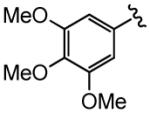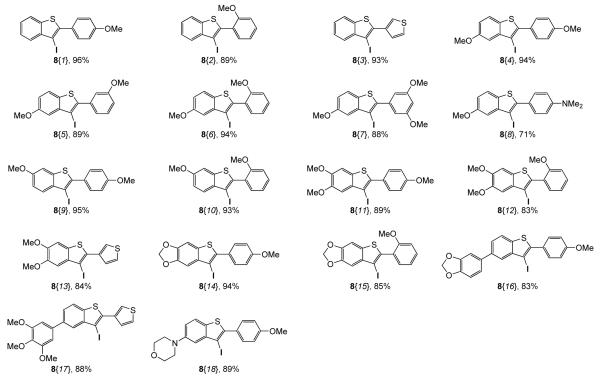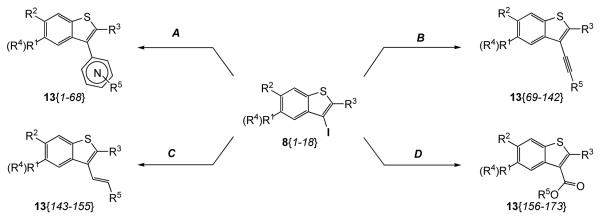Abstract
Synthesis of a Benzo[b]thiophene Library
Generation of a library using parallel syntheses of multi-substituted benzo[b]thiophenes is described. The requisite 3-iodobenzo[b]thiophenes are readily prepared in excellent yields from various alkynes bearing electron-rich aromatic rings by electrophilic cyclization using I2 in CH2Cl2. The heteroaromatic carbon-iodine bonds allow further diversification by palladium-catalyzed Suzuki-Miyaura, Sonogashira, Heck and carboalkoxylation chemistry to give multi-substituted benzo[b]thiophene derivatives.
Introduction
Solution-phase parallel synthesis and related multiple synthesis technologies are well established in modern drug discovery, especially in medicinal chemistry, for the preparation of low molecular weight compound libraries.1-3 Thus, parallel synthesis to generate structural diversity has enabled high throughput screening of larger and more diverse pools of compounds as starting points for optimization efforts.4-7
The benzo[b]thiophene ring system and its derivatives are present in several drug candidates, which exhibit some interesting biological properties, e.g. as antitumor,8-10 antibacterial,11 antibiotic,12 antipsychotic,13 anti-inflammatory,14-16 antiallergic,17 antimicrobial,18 antithrombotic-fibrilonitic19 and antifungal20 agents. Indeed, raloxifene (1) and arzoxifene (2) have well-recognized pharmacological properties, serving as potent selective estrogen receptor modulators (SERMs),21-30 as well as tubulin-binding agents,21,31-34 to name just a few. The natural product combretastatin A-4 (CA-4, 3) is one of the most potent inhibitors of tubulin polymerization, binding at the colchicine site on the protein.35-37 3-Aroyl-2-aryl-6-methoxybenzo[b]thiophene analogues 4 have also been identified as a core structure present in a series of inhibitors of tubulin polymerization.31,33 The 3-aroyl-2-arylbenzo[b]thiophene ring system and the methoxy-aryl substitution pattern are particularly important for the potent activity of combretastatin A-4 (3) (Figure 1). Recently, numerous multi-substituted benzo[b]thiophene analogues have emerged as molecules possessing real synthetic utility and a wide array of biological activities.38-42
Figure 1.
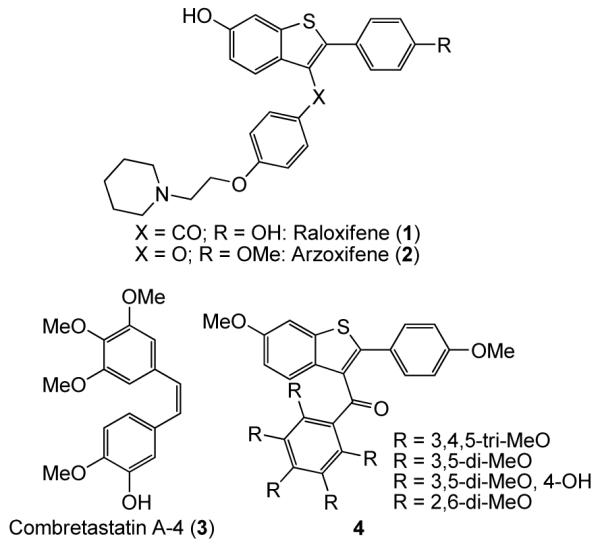
Chemical structures of raloxifene (1), arzoxifene (2), combretastatin A-4 (3), and 3-aroyl-2-aryl-6-methoxybenzo[b]thiophene analogues 4
We have previously developed an efficient synthesis of 2,3-disubstituted benzo[b]thiophenes by the palladium/copper-catalyzed cross-coupling of various o-iodothioanisoles and terminal alkynes, followed by electrophilic cyclization by I2, Br2, NBS, PhSeCl or p-O2NC6H4SCl under mild conditions (Scheme 1).43,44 In continuation of our library work, the multi-substituted benzo[b]thiophene template 13 has been evaluated computationally for its drug-like properties on the basis of Lipinski’s “rule of five”.45,46 Lipinski calculations have been performed based on the commercial availability of boronic acids 9, terminal alkynes 10, styrenes 11, and alcohols 12 and this data has been used to populate a virtual library of all theoretically possible products, giving roughly 5500 (11×8×36, 7×16×19, 5×4×11) unique potential compounds. A small subset of this virtual library, namely 171 compounds, follows Lipinski’s rules with no violations. Many of these compounds have now been prepared for possible biological screening.
Scheme 1.
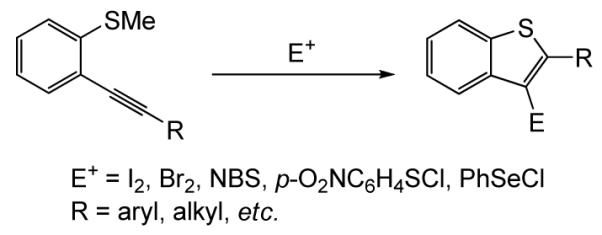
Results and Discussion
To study a wide variety of benzo[b]thiophene derivatives 13, we decided to explore strategies using cross-coupling and iodocyclization methodologies that would allow us many degrees of flexibility in introducing a large diversity of functionalities for medicinally-interesting drug-like benzo[b]thiophene derivatives. Retrosynthetically, the key compounds in our overall synthetic route were identified as the 3-iodobenzo[b]thiophenes 8. A diverse library of benzo[b]thiophene derivatives 13 could be readily elaborated through various palladium-catalyzed cross-coupling reactions at the C-3 carbon-iodine position in such iodobenzothiophenes (Scheme 2).
Scheme 2.
In the first-generation diversification step, the dihalobenzene starting materials 5{1,3,4} were easily prepared in virtually quantitative yields as single isomers through regioselective bromination47 of commercially available substituted iodobenzenes, e.g. 1-iodo-3-methoxybenzene, 1-iodo-3,4-dimethoxybenzene, and 1-iodo-3,4-(methylenedioxy)benzene using bromine. The iodination of 3-bromoanisole was attempted using I2 and 1-(tosyloxy)benziodoxolone (an arenesulfonyl hypoiodite)48 as an iodonium salt in CH3CN for 3 h at room temperature. This resulted in a 43% yield of a mixture of two inseparable iodinated products 5{2}.49 4-Bromo-2-iodothioanisole [5{5}] was prepared according to a literature procedure.50 2-Iodothioanisole [5{6}] was obtained commercially. The previously mentioned chemistry allows us to efficiently synthesize 3-iodobenzo[b]thiophenes 8 with a large variety of substituents at the C-2, C-5, and C-6 positions. In general, the requisite precursors bearing multiple substituents and an alkyne moiety (6) can be easily prepared by the palladium/copper-catalyzed Sonogashira coupling51 of the corresponding aryl dihalides 5 (1.0 equiv of 5, 1.05 equiv of terminal alkyne 10, 2 mol % of PdCl2(PPh3)2, 2 mol % of CuI, and Et3N at 50 °C for 5-8 h) (Scheme 3). This procedure readily accommodates additional halogens on the aromatic ring, i.e. substitution of the iodine functionality is chemoselective over the bromine functionality for Sonogashira reactions. The results were summarized in Table 1.
Scheme 3.
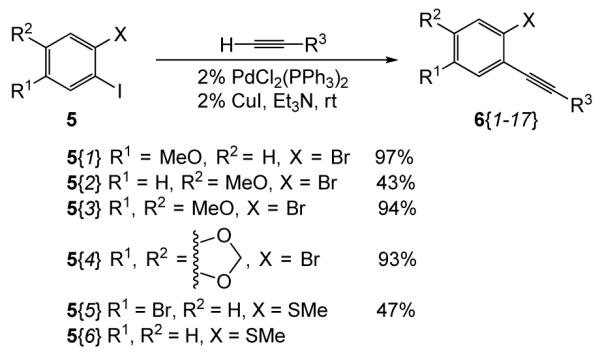
Table 1.
Library Data for Compounds 6{1-17}
 | ||||
|---|---|---|---|---|
| entry | 5 | R3 | compd 6 | yield (%)a |
| 1 | 5{1} | 4-MeOC6H4 | 6{1} | 94 |
| 2 | 5{1} | 3-MeOC6H4 | 6{2} | 91 |
| 3 | 5{1} | 2-MeOC6H4 | 6{3} | 87 |
| 4 | 5{1} | 3,5-(MeO)2C6H3 | 6{4} | 83 |
| 5 | 5{1} | 4-Me2NC6H4 | 6{5} | 71 |
| 6 | 5{2} | 4-MeOC6H4 | 6{6} | 73 |
| 7 | 5{2} | 2-MeOC6H4 | 6{7} | 77 |
| 8 | 5{3} | 4-MeOC6H4 | 6{8} | 92 |
| 9 | 5{3} | 2-MeOC6H4 | 6{9} | 71 |
| 10 | 5{3} | 3-thiophenyl | 6{10} | 87 |
| 11b | 5{4} | 4-MeOC6H4 | 6{11} | 84 |
| 12b | 5{4} | 2-MeOC6H4 | 6{12} | 83c |
| 13 | 5{5} | 4-MeOC6H4 | 6{13} | 88 |
| 14 | 5{5} | 3-thiophenyl | 6{14} | 83c |
| 15 | 5{6} | 4-MeOC6H4 | 6{15} | 88 |
| 16 | 5{6} | 2-MeOC6H4 | 6{16} | 79 |
| 17 | 5{6} | 3-thiophenyl | 6{17} | 87 |
Isolated yields after column chromatography. All compounds 6 were characterized by 1H and 13C NMR spectroscopy.
This reaction used DMF as the solvent.
An inseparable mixture was obtained.
As can be seen from the results reported in Table 2, a sequence of reactions involving Sonogashira coupling of the bromo-iodoarenes 5, and subsequent lithiation of compounds 6{1-12} with n-BuLi, followed by methylthiolation with dimethyl disulfide afforded the corresponding sulfide products 7. The crude reaction mixtures were purified by column chromatography, affording good to excellent yields of the sulfides.
Table 2.
Library Data for Compounds 7{1-12}
 | ||||
|---|---|---|---|---|
| compd 7 | R1 | R2 | R3 | yield(%)a |
| 7{1} | MeO | H | 4-MeOC6H4 | 86 |
| 7{2} | MeO | H | 3-MeOC6H4 | 87 |
| 7{3} | MeO | H | 2-MeOC6H4 | 93 |
| 7{4} | MeO | H | 3,5-(MeO)2C6H3 | 63 |
| 7{5} | MeO | H | 4-Me2NC6H4 | 79 |
| 7{6} | H | MeO | 4-MeOC6H4 | 89 |
| 7{7} | H | MeO | 2-MeOC6H4 | 91 |
| 7{8} | MeO | MeO | 4-MeOC6H4 | 83 |
| 7{9} | MeO | MeO | 2-MeOC6H4 | 81 |
| 7{10} | MeO | MeO | 3-thiophenyl | 79b |
| 7{11} | 4-MeOC6H4 | 63 | ||
| 7{12} | 2-MeOC6H4 | 90 | ||
Isolated yields after column chromatography. All compounds 7 have been characterized by 1H and 13C NMR spectroscopy.
An inseparable mixture was obtained.
Having achieved efficient access to 6{13} and 6{14}, we then turned to substitution of the bromo group at the C-4 position. Both 6{13} and 6{14} reacted readily with two different boronic acids under standard Suzuki-Miyaura conditions52,53 in the presence of Pd(PPh3)4 and K2CO3 at 80 °C in aqueous toluene/ethanol. Under these conditions, the reactions were complete within 6 h, providing the corresponding cross-coupled products 7{13-14} in modest yields. Moreover, the corresponding alkyne amine 7{15} was synthesized in good yield by the Buchwald-Hartwig amination of bromoalkyne 6{13} with morpholine (Table 3).54
Table 3.
Library Data for Compounds 7{13-15}
Isolated yields after column chromatography. All compounds 7 have been characterized by 1H and 13C NMR spectroscopy.
5 Mol % Pd(PPh3)4, K2CO3 (3.0 equiv), and ArB(OH)2 9{3,5} (1.5 equiv) in toluene/EtOH/H2O (20/5/1), 80 °C.
5 Mol % Pd2(dba)3, DavePhos (0.1 equiv), NaOtBu (1.4 equiv), and morpholine (1.5 equiv) in toluene, 60 °C.
The key step in our methodology involves the formation of various substituted 3-iodobenzo[b]thiophenes 8 by electrophilic cyclization of the corresponding methylthio-containing alkynes 6{15-17} and 7{1-15} using I2 for 10 min at room temperature (Scheme 4). According to the 1H NMR spectra for the reaction mixtures obtained before purification, the methylthio-containing alkynes 6{15-17} and 7{1-15} are converted cleanly into their respective 3-iodobenzo[b]thiophenes 8. All of the products are easily isolated by column chromatography in high yields (see the Supporting Information for the experimental details). The results are summarized in Figure 2.
Scheme 4.

Figure 2.
3-Iodobenzo[b]thiophene library 8{1-18}
Finally, the 3-iodobenzo[b]thiophenes 8 can be further elaborated using a variety of palladium-mediated processes, such as Suzuki-Miyaura coupling,52,53 Sonogashira coupling,51 Heck coupling,55 and carboalkoxylation56 (Scheme 5).
Scheme 5.
Method A (Suzuki-Miyaura coupling): 10 mol % Pd(PPh3)4, K2CO3 (2.5 equiv), (Het)ArB(OH)2 (9, 1.5 equiv), toluene/EtOH/H2O (20/5/1), reflux; Method B (Sonogashira coupling): 3 mol % PdCl (PPh3)2, 3 mol % CuI, Et2NH, R5C≡CH (10, 1.2 equiv), DMF, 100 °C, 20 min, using microwave irradiation; Method C (Heck coupling): 5 mol % Pd(OAc)2, n-Bu NI (1.0 equiv), Na2CO3 (2.5 equiv), R5CH=CH2 (11, 1.2 equiv), DMF, 80 °C; Method D (carboalkoxylation): CO (1 atm), 3 mol % Pd(OAc)2, 5 mol % dppf, TEA (2.0 equiv), R5OH (12, 1.5 equiv), DMF, 70 °C.
The 3-iodobenzo[b]thiophenes 8 bearing a carbon-iodine bond at the C-3 position generally survive the use of high temperatures and basic conditions. The Suzuki-Miyaura coupling of the 3-iodobenzo[b]thiophenes 8 with various arylboronic acids 9 proceeded smoothly to give the desired products 13{1-68} in refluxing aqueous toluene/ethanol as a co-solvent within 6 h (Method A, Table 4). Deprotection of the tetrahydropyranyl (THP) ether group in such derivatives was carried out using 10% aq HCl in THF at room temperature to give quantitative yields of the desired products 13{1,11,17,20,25,31,37,42,47,51,55,59}.57 The commercially available boronic acids 9 were chosen because they contain heterocycles and polar functionality that would incorporate drug-like moieties in the resulting coupling products (Figure 3). Fluorine atom-containing arylboronic acids 9{10}, 9{11}, 9{12}, and 9{19} were chosen because the resulting organofluorine Suzuki-Miyaura coupling products should be of considerable interest for various applications in industry and medicine.58,59 Sonogashira coupling of the 3-iodobenzo[b]thiophenes 8 with various terminal alkynes 10 nicely provides the corresponding alkyne products 13{69-142} under microwave irradiation (Method B, Table 5).51 The terminal alkynes 10 were chosen because they are commercially available heteroatom-containing acetylenes (Figure 4). Under our reaction conditions, microwave irradiation has been shown not only to reduce the reaction times, but often provides higher yields of the desired alkyne products 13{69-142} when compared to conventional heating methods. In addition, we have been able to perform Heck coupling on the 3-iodobenzo[b]thiophenes 8. By allowing the compound to react under Heck reaction conditions in the presence of the commercially available heteroatom-containing styrenes 11 (Figure 5), we have obtained the corresponding substituted olefin-containing benzo[b]thiophene products 13{143-155} (Method C, Table 6).55 Finally, carboalkoxylation of the 3-iodobenzo[b]thiophenes 8 using one atmosphere of carbon monoxide and two different primary alcohols 12 in the presence of catalytic amounts of Pd(OAc)2 and dppf ligand afforded the ester-containing benzo[b]thiophenes 13{156-173} (Method D, Table 7).56
Table 4.
Library Data for Compounds 13{1-68}
| product | 8 | 9 | yield (%)a | purity (%)d | product | 8 | 9 | yield (%)b | purity (%)d |
|---|---|---|---|---|---|---|---|---|---|
| 13{1} | 8{1} | 9{8} | 83b,c | 97 | 13{35} | 8{6} | 9{19} | 58 | 98 |
| 13{2} | 8{1} | 9{10} | 72 | >99 | 13{36} | 8{7} | 9{1} | 68b | >99 |
| 13{3} | 8{1} | 9{13} | 71 | >99 | 13{37} | 8{7} | 9{8} | 71b,c | >99 |
| 13{4} | 8{1} | 9{16} | 75 | 99 | 13{38} | 8{7} | 9{13} | 53 | 98 |
| 13{5} | 8{2} | 9{1} | 89 | >99 | 13{39} | 8{7} | 9{17} | 82 | 99 |
| 13{6} | 8{2} | 9{2} | 85b | >99 | 13{40} | 8{8} | 9{14} | 77 | 97 |
| 13{7} | 8{2} | 9{4} | 58b | 99 | 13{41} | 8{8} | 9{17} | 79 | 98 |
| 13{8} | 8{2} | 9{5} | 62 | >99 | 13{42} | 8{9} | 9{8} | 64b,c | >99 |
| 13{9} | 8{2} | 9{6} | 88 | >99 | 13{43} | 8{9} | 9{11} | 66 | >99 |
| 13{10} | 8{2} | 9{7} | 88 | >99 | 13{44} | 8{9} | 9{17} | 58 | 98 |
| 13{11} | 8{2} | 9{8} | 87b,c | 99 | 13{45} | 8{9} | 9{20} | 37 | 99 |
| 13{12} | 8{2} | 9{12} | 81 | >99 | 13{46} | 8{10} | 9{6} | 71 | >99 |
| 13{13} | 8{2} | 9{15} | 82 | 97 | 13{47} | 8{10} | 9{8} | 58b,c | >99 |
| 13{14} | 8{2} | 9{18} | 67 | >99 | 13{48} | 8{11} | 9{6} | 81 | 93 |
| 13{15} | 8{3} | 9{3} | 91 | 99 | 13{49} | 8{11} | 9{8} | 61b,c | 97 |
| 13{16} | 8{3} | 9{7} | 86 | >99 | 13{50} | 8{11} | 9{15} | 59 | 99 |
| 13{17} | 8{3} | 9{8} | 67b,c | >99 | 13{51} | 8{12} | 9{8} | 53b,c | >99 |
| 13{18} | 8{3} | 9{9} | 77 | >99 | 13{52} | 8{12} | 9{12} | 71 | >99 |
| 13{19} | 8{3} | 9{15} | 82 | >99 | 13{53} | 8{14} | 9{6} | 88 | >99 |
| 13{20} | 8{4} | 9{8} | 61b,c | 98 | 13{54} | 8{14} | 9{7} | 78 | 76 |
| 13{21} | 8{4} | 9{12} | 89 | >99 | 13{55} | 8{14} | 9{8} | 68b,c | >99 |
| 13{22} | 8{4} | 9{13} | 88 | >99 | 13{56} | 8{14} | 9{12} | 64b | 98 |
| 13{23} | 8{4} | 9{16} | 71b | 99 | 13{57} | 8{14} | 9{15} | 32 | 88 |
| 13{24} | 8{5} | 9{5} | 68 | >99 | 13{58} | 8{15} | 9{5} | 83 | 97 |
| 13{25} | 8{5} | 9{8} | 65b,c | >99 | 13{59} | 8{15} | 9{8} | 69b,c | 99 |
| 13{26} | 8{5} | 9{9} | 81 | >99 | 13{60} | 8{15} | 9{9} | 77b | >99 |
| 13{27} | 8{5} | 9{10} | 82 | >99 | 13{61} | 8{15} | 9{19} | 74 | >99 |
| 13{28} | 8{5} | 9{11} | 78 | 98 | 13{62} | 8{16} | 9{7} | 77 | >99 |
| 13{29} | 8{5} | 9{20} | 74 | >99 | 13{63} | 8{16} | 9{13} | 81b | 99 |
| 13{30} | 8{6} | 9{6} | 87 | >99 | 13{64} | 8{18} | 9{1} | 69b | >99 |
| 13{31} | 8{6} | 9{8} | 82b,c | >99 | 13{65} | 8{18} | 9{8} | 66 | >99 |
| 13{32} | 8{6} | 9{12} | 73 | >99 | 13{66} | 8{18} | 9{12} | 59b | >99 |
| 13{33} | 8{6} | 9{13} | 83 | >99 | 13{67} | 8{18} | 9{15} | 47 | 99 |
| 13{34} | 8{6} | 9{17} | 71 | 83 | 13{68} | 8{18} | 9{17} | 51 | 97 |
Isolated yield after preparative HPLC.
Isolated yield after column chromatography.
The THP ether-protected boronic acid 10{9} was deprotected in situ using aq HCl in THF at room temperature.
UV purity determined at 214 nm after preparative HPLC.
Figure 3.
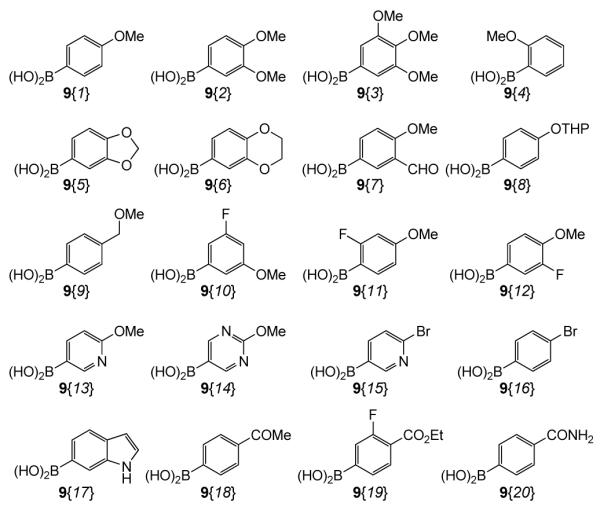
Boronic acid 9{1-20} sublibrary
Table 5.
Library Data for Compounds 13{69-142}
| product | 8 | 10 | yield (%)a | purity (%)c | product | 8 | 10 | yield (%)a | purity (%)c |
|---|---|---|---|---|---|---|---|---|---|
| 13{69} | 8{1} | 10{1} | 58b | >99 | 13{106} | 8{8} | 10{9} | 73 | >99 |
| 13{70} | 8{1} | 10{2} | 41b | >99 | 13{107} | 8{8} | 10{12} | 36 | 99 |
| 13{71} | 8{1} | 10{6} | 57b | >99 | 13{108} | 8{9} | 10{2} | 71 | >99 |
| 13{72} | 8{1} | 10{9} | 67 | >99 | 13{109} | 8{9} | 10{5} | 73 | >99 |
| 13{73} | 8{2} | 10{1} | 43 | 99 | 13{110} | 8{9} | 10{6} | 59 | >99 |
| 13{74} | 8{2} | 10{6} | 73 | >99 | 13{111} | 8{11} | 10{1} | 51 | >99 |
| 13{75} | 8{2} | 10{7} | 67 | >99 | 13{112} | 8{11} | 10{2} | 80b | 95 |
| 13{76} | 8{2} | 10{8} | 53 | 82 | 13{113} | 8{11} | 10{4} | 75 | >99 |
| 13{77} | 8{2} | 10{12} | 14 | 98 | 13{114} | 8{11} | 10{6} | 74b | 95 |
| 13{78} | 8{3} | 10{1} | 51 | 96 | 13{115} | 8{11} | 10{10} | 11 | 72 |
| 13{79} | 8{3} | 10{2} | 36 | 97 | 13{116} | 8{12} | 10{2} | 78 | >99 |
| 13{80} | 8{3} | 10{3} | 82 | >99 | 13{117} | 8{13} | 10{8} | 68 | 99 |
| 13{81} | 8{3} | 10{6} | 71 | >99 | 13{118} | 8{13} | 10{13} | 56 | >99 |
| 13{82} | 8{3} | 10{7} | nr | - | 13{119} | 8{14} | 10{1} | 53 | 98 |
| 13{83} | 8{3} | 10{8} | 56 | 93 | 13{120} | 8{14} | 10{4} | 68 | >99 |
| 13{84} | 8{3} | 10{9} | 72 | >99 | 13{121} | 8{14} | 10{6} | 66 | 97 |
| 13{85} | 8{3} | 10{13} | 28 | 83 | 13{122} | 8{14} | 10{7} | 74 | 91 |
| 13{86} | 8{4} | 10{2} | 85 | 95 | 13{123} | 8{14} | 10{9} | 63 | 96 |
| 13{87} | 8{4} | 10{5} | 63 | 99 | 13{124} | 8{14} | 10{11} | 77 | >99 |
| 13{88} | 8{4} | 10{9} | 75 | >99 | 13{125} | 8{14} | 10{14} | 23 | 52 |
| 13{89} | 8{4} | 10{10} | 69 | 98 | 13{126} | 8{15} | 10{1} | 45 | 98 |
| 13{90} | 8{5} | 10{2} | 66b | >99 | 13{127} | 8{15} | 10{4} | 69 | 86 |
| 13{91} | 8{5} | 10{4} | 71 | >99 | 13{128} | 8{15} | 10{6} | 81 | 91 |
| 13{92} | 8{5} | 10{5} | 69 | 99 | 13{129} | 8{15} | 10{9} | 72 | >99 |
| 13{93} | 8{5} | 10{6} | 72 | >99 | 13{130} | 8{15} | 10{10} | 62 | 93 |
| 13{94} | 8{5} | 10{10} | 81 | 88 | 13{131} | 8{16} | 10{2} | 67 | >99 |
| 13{95} | 8{6} | 10{2} | 72 | 99 | 13{132} | 8{16} | 10{4} | 61 | >99 |
| 13{96} | 8{6} | 10{4} | 65b | >99 | 13{133} | 8{16} | 10{9} | 48 | 97 |
| 13{97} | 8{6} | 10{9} | 72 | 99 | 13{134} | 8{17} | 10{1} | 73b | 89 |
| 13{98} | 8{7} | 10{1} | 58 | 98 | 13{135} | 8{17} | 10{6} | nr | - |
| 13{99} | 8{7} | 10{2} | 68 | 95 | 13{136} | 8{17} | 10{8} | 53 | 98 |
| 13{100} | 8{7} | 10{4} | 78 | 94 | 13{137} | 8{17} | 10{10} | 48 | 95 |
| 13{101} | 8{7} | 10{7} | 53 | >99 | 13{138} | 8{18} | 10{1} | 38 | 99 |
| 13{102} | 8{8} | 10{1} | 58b | >99 | 13{139} | 8{18} | 10{2} | 41 | 98 |
| 13{103} | 8{8} | 10{2} | 63 | >99 | 13{140} | 8{18} | 10{4} | 55 | 96 |
| 13{104} | 8{8} | 10{4} | 70 | >99 | 13{141} | 8{18} | 10{6} | 78 | >99 |
| 13{105} | 8{8} | 10{7} | 61 | >99 | 13{142} | 8{18} | 10{8} | 60 | >99 |
Isolated yield after preparative HPLC.
Isolated yield after column chromatography.
UV purity determined at 214 nm after preparative HPLC.
Figure 4.
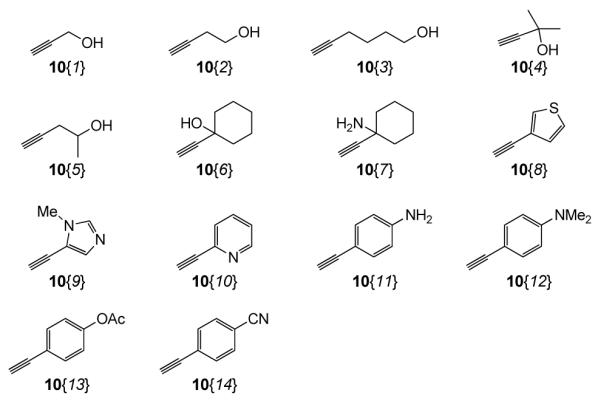
Terminal alkyne 10{1-14} sublibrary
Figure 5.
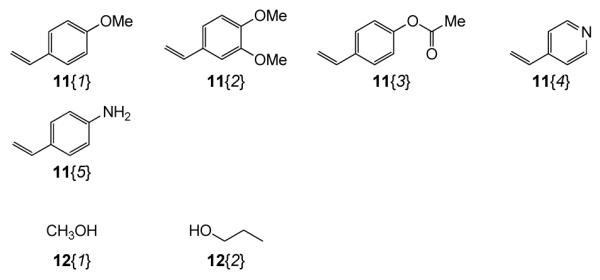
Styrene 11{1-5} and alcohol 12{1-2} sublibrary
Table 6.
Library Data for Compounds 13{143-155}
| product | 8 | 11 | yield (%)a | purity (%)c |
|---|---|---|---|---|
| 13{143} | 8{1} | 11{1} | 31 | 92 |
| 13{144} | 8{1} | 11{2} | 39 | 85 |
| 13{145} | 8{1} | 11{3} | 11 | 95 |
| 13{146} | 8{1} | 11{4} | 68b | 93 |
| 13{147} | 8{1} | 11{5} | 17 | 96 |
| 13{148} | 8{2} | 11{2} | 88 | 96 |
| 13{149} | 8{2} | 11{3} | 78 | 95 |
| 13{150} | 8{3} | 11{3} | 47 | 95 |
| 13{151} | 8{5} | 11{2} | 86b | >99 |
| 13{152} | 8{6} | 11{2} | 53 | 96 |
| 13{153} | 8{6} | 11{3} | 47 | 97 |
| 13{154} | 8{11} | 11{1} | 77b | 95 |
| 13{155} | 8{18} | 11{1} | 23b | 97 |
Isolated yield after preparative HPLC.
Isolated yield after column chromatography.
UV purity determined at 214 nm after preparative HPLC.
Table 7.
Library Data for Compounds 13{156-173}
| product | 8 | 12 | yield (%)a | purity (%)c |
|---|---|---|---|---|
| 13{156} | 8{2} | 12{1} | 74 | >99 |
| 13{157} | 8{3} | 12{1} | 68 | >99 |
| 13{158} | 8{3} | 12{2} | 57 | >99 |
| 13{159} | 8{4} | 12{1} | 86b | >99 |
| 13{160} | 8{5} | 12{1} | 53 | >99 |
| 13{161} | 8{5} | 12{2} | 87b | 82 |
| 13{162} | 8{6} | 12{1} | 34 | >99 |
| 13{163} | 8{7} | 12{1} | 70b | >99 |
| 13{164} | 8{8} | 12{1} | 93 | >99 |
| 13{165} | 8{8} | 12{2} | 47 | 98 |
| 13{166} | 8{11} | 12{1} | 85b | >99 |
| 13{167} | 8{12} | 12{1} | 67 | >99 |
| 13{168} | 8{14} | 12{1} | 56b | >99 |
| 13{169} | 8{15} | 12{1} | 61 | 99 |
| 13{170} | 8{16} | 12{1} | 87 | >99 |
| 13{171} | 8{16} | 12{2} | 73 | 99 |
| 13{172} | 8{17} | 12{1} | 73b | >99 |
| 13{173} | 8{18} | 12{1} | 68b | >99 |
Isolated yield after preparative HPLC.
Isolated yield after column chromatography.
UV purity determined at 214 nm after preparative HPLC.
The process as a whole is quite functional group tolerant and efficient. These reactions have been performed in parallel on approximately a 35∼45 mg scale, starting from the 3-iodobenzo[b]thiophenes 8. All of the crude products 13 were isolated by either column chromatography or preparative HPLC. The purity of the reaction mixtures has been analyzed by TLC, LC-MS, and HPLC. The results of this parallel library synthesis are summarized in Tables 4-7. We have used Lipinski’s rule of five45,46 as a general guide for bioavailability, because compounds with poor bioavailability face more of a challenge in becoming successful clinical candidates. The molecular weight (less than 500), clogP (less than 5), number of hydrogen bond donors (less than 5 H) and acceptors (less than 10 H), and the number of rotatable bonds (less than 10) were calculated for each of the library members using the SYBYL60 program. The majority of the selected 171 benzo[b]thiophene library members are Lipinski compliant.
In summary, a simple and efficient method for the parallel synthesis of multi-substituted benzo[b]thiophenes 13 has been developed via palladium-catalyzed couplings, such as Suzuki-Miyaura, Sonogashira, Heck, and carboalkoxylation chemistry, using a diverse set of building blocks and starting from the 3-iodobenzo[b]thiophenes 8. This chemistry has provided pure 20+ mg samples of each library compound. The elaborated multi-substituted benzo[b]thiophene 13 library members have been added to the Kansas University NIH Center for Chemical Methodologies and Library Development (KU CMLD) collection and will be submitted to the National Institutes of Health Molecular Library Screening Center Network (MLSCN) for evaluation by a broad range of assays.
Supplementary Material
Acknowledgment
We thank the National Institute of General Medical Sciences (GM070620 and GM079593) and the National Institutes of Health Kansas University Chemical Methodologies and Library Development Center of Excellence (GM069663) for support of this research; Johnson Matthey, Inc. and Kawaken Fine Chemicals Co. Ltd. for donations of palladium catalysts; and Frontier Scientific and Synthonix for donations of boronic acids.
References and Notes
- (1).An HY, Cook PD. Chem. Rev. 2000;100:3311–3340. doi: 10.1021/cr990014r. [DOI] [PubMed] [Google Scholar]
- (2).Sun CM. Comb. Chem. High Throughput Screening. 1999;2:299–318. [PubMed] [Google Scholar]
- (3).Merritt AT. Comb. Chem. High Throughput Screening. 1998;1:57–72. [PubMed] [Google Scholar]
- (4).Goodnow RA, Jr., Guba W, Haap W. Comb. Chem. High Throughput Screening. 2003;6:649–660. doi: 10.2174/138620703771981214. [DOI] [PubMed] [Google Scholar]
- (5).Schuffenhauer A, Popov M, Schopfer U, Acklin P, Stanek J, Jacoby EC. Comb. Chem. High Throughput Screening. 2004;7:771–781. doi: 10.2174/1386207043328238. [DOI] [PubMed] [Google Scholar]
- (6).Waldo JP, Mehta S, Neuenswander B, Lushington GH, Larock RC. J. Comb. Chem. 2008;10:658–663. doi: 10.1021/cc800055x. [DOI] [PMC free article] [PubMed] [Google Scholar]
- (7).Cho C-H, Neuenswander B, Lushington GH, Larock RC. J. Comb. Chem. 2008;10:941–947. doi: 10.1021/cc800120y. [DOI] [PMC free article] [PubMed] [Google Scholar]
- (8).Witter DJ, Belvedere S, Chen L, Secrist JP, Mosley RT, Miller TA. Bioorg. Med. Chem. Lett. 2007;17:4562–4567. doi: 10.1016/j.bmcl.2007.05.091. [DOI] [PubMed] [Google Scholar]
- (9).Jarak I, Kralj M, Suman L, Pavlovic G, Dogan J, Piantanida I, Zinic M, Pavelic K, Karminski-Zamola G. J. Med. Chem. 2005;48:2346–2360. doi: 10.1021/jm049541f. [DOI] [PubMed] [Google Scholar]
- (10).Innocenti A, Villar R, Martinez-Merino V, Gil MJ, Scozzafava A, Vullo D, Supuran CT. Bioorg. Med. Chem. Lett. 2005;15:4872–4876. doi: 10.1016/j.bmcl.2005.04.078. [DOI] [PubMed] [Google Scholar]
- (11).Fournier Dit Chabert J, Marquez B, Neville L, Joucla L, Broussous S, Bouhours P, David E, Pellet-Rostaing S, Marquet B, Moreau N, Lemaire M. Bioorg. Med. Chem. 2007;15:4482–4497. doi: 10.1016/j.bmc.2007.04.023. [DOI] [PubMed] [Google Scholar]
- (12).Venturelli A, Tondi D, Cancian L, Morandi F, Cannazza G, Segatore B, Prati F, Amicosante G, Shoichet BK, Costi MP. J. Med. Chem. 2007;50:5644–5654. doi: 10.1021/jm070643q. [DOI] [PubMed] [Google Scholar]
- (13).Hrib NJ, Jurcak JG, Bregna DE, Dunn RW, Geyer HM, Hartman HB, Roehr JR, Rogers KL, Rush DK, Szczepanik AM, Szewczak MR, Wilmot CA, Conway PG. J. Med. Chem. 1992;35:2712–2715. doi: 10.1021/jm00092a024. [DOI] [PubMed] [Google Scholar]
- (14).Boschelli DH, Kramer JB, Khatana SS, Sorenson RJ, Connor DT, Ferin MA, Wright CD, Lesch ME, Imre K, Okonkwo GC, Schrier DJ, Conroy MC, Ferguson E, Woelle J, Saxena U. J. Med. Chem. 1995;38:4597–4614. doi: 10.1021/jm00022a026. [DOI] [PubMed] [Google Scholar]
- (15).Bleavins MR, de la Igelsia FA, McCay JA, White L, Kimber L, Jr., Munson AE. Toxicology. 1995;98:111–123. doi: 10.1016/0300-483x(94)02985-4. [DOI] [PubMed] [Google Scholar]
- (16).Boschelli DH, Connor DT, Lesch ME, Schrier DJ. Bioorg. Med. Chem. 1996;4:557–562. doi: 10.1016/0968-0896(96)00046-6. [DOI] [PubMed] [Google Scholar]
- (17).Boschelli DH, Kramer JB, Khatana SS, Sorenson RJ, Connor DT, Ferin MA, Wright CD, Lesch ME, Imre K, Okonkwo GC, Schrier DJ, Conroy MC, Ferguson E, Woelle J, Saxena U. J. Med. Chem. 1992;35:958–968. doi: 10.1021/jm00022a026. [DOI] [PubMed] [Google Scholar]
- (18).Queiroz M-JRP, Ferreira ICFR, Gaetano YD, Kirsch G, Calhelha RC, Estevinho LM. Bioorg. Med. Chem. 2006;14:6827–6831. doi: 10.1016/j.bmc.2006.06.035. [DOI] [PubMed] [Google Scholar]
- (19).De Nanteuil G, Lila-Ambroise C, Vallez M-O, Verbeuren TJ. Bioorg. Med. Chem. Lett. 2003;13:1705–1708. doi: 10.1016/s0960-894x(03)00233-6. [DOI] [PubMed] [Google Scholar]
- (20).Pinto E, Queiroz M-JRP, Vale-Silva LA, Oliveira JF, Begouin A, Begouin J-M, Kirsch G. Bioorg. Med. Chem. 2008;16:8172–8177. doi: 10.1016/j.bmc.2008.07.042. [DOI] [PubMed] [Google Scholar]
- (21).Romagnoli R, Baraldi PG, Carrion MD, Lopez Cara C, Preti D, Fruttarolo F, Pavani MG, Tabrizi MA, Tolomeo M, Grimaudo S, Di Antonella C, Balzarini J, Hadfield JA, Brancale A, Hamel E. J. Med. Chem. 2007;50:2273–2277. doi: 10.1021/jm070050f. [DOI] [PubMed] [Google Scholar]
- (22).Jones CD, Jevnikar MG, Pike AJ, Peters MK, Black LJ, Thompson AR, Falcone JF, Clemens JA. J. Med. Chem. 1984;27:1057–1066. doi: 10.1021/jm00374a021. [DOI] [PubMed] [Google Scholar]
- (23).Magarian RA, Overacre LB, Singh S, Meyer KL. Curr. Med. Chem. 1994;1:61–86. [Google Scholar]
- (24).Palkowitz AD, Glasebrook AL, Thrascher KJ, Hauser KL, Short LL, Phillip DL, Muehl BS, Sato M, Shetler PK, Cullinan GJ, Pell TR, Bryant HU. J. Med. Chem. 1997;40:1407–1416. doi: 10.1021/jm970167b. [DOI] [PubMed] [Google Scholar]
- (25).Schopfer U, Schoeffter P, Bischoff SF, Nozulak J, Feuerbach D, Floersheim P. J. Med. Chem. 2002;45:1399–1401. doi: 10.1021/jm015577l. [DOI] [PubMed] [Google Scholar]
- (26).Overk CR, Peng K-W, Asghodom RT, Kastrati I, Lantvit DD, Qin Z, Frasor J, Bolton JL, Thatcher GRL. ChemMedChem. 2007;2:1520–1526. doi: 10.1002/cmdc.200700104. [DOI] [PubMed] [Google Scholar]
- (27).Qin Z, Kastrati I, Chandrasena RE, Liu H, Yao P, Petukhov PA, Bolton JL, Thatcher GRL. J. Med. Chem. 2007;50:2682–2692. doi: 10.1021/jm070079j. [DOI] [PubMed] [Google Scholar]
- (28).Jordan VC, Phelps E, Lindgren JU. Breast Cancer Res. Treat. 1987;10:31–35. doi: 10.1007/BF01806132. [DOI] [PubMed] [Google Scholar]
- (29).Liu H, Liu J, van Breemen RB, Thatcher GRJ, Bolton JL. Chem. Res. Toxicol. 2005;18:162–173. doi: 10.1021/tx049776u. [DOI] [PubMed] [Google Scholar]
- (30).Flynn BL, Hamel E, Jung MK. J. Med. Chem. 2002;45:2670–2673. doi: 10.1021/jm020077t. [DOI] [PubMed] [Google Scholar]
- (31).Pinney KG, Bounds AD, Dingeman KM, Mocharla VP, Pettit GR, Bai R, Hamel E. Bioorg. Med. Chem. Lett. 1999;9:1081–1086. doi: 10.1016/s0960-894x(99)00143-2. [DOI] [PubMed] [Google Scholar]
- (32).Zhang S-X, Bastow KF, Tachibana Y, Kuo S-C, Hamel E, Mauger A, Narayanan VL, Lee K-H. J. Med. Chem. 1999;42:4081–4087. doi: 10.1021/jm990208z. [DOI] [PubMed] [Google Scholar]
- (33).Flynn BL, Verdier-Pinard P, Hamel E. Org. Lett. 2001;3:651–654. doi: 10.1021/ol0067179. [DOI] [PubMed] [Google Scholar]
- (34).Chen Z, Mocharla VP, Farmer JM, Pettit GR, Hamel E, Pinney KG. J. Org. Chem. 2000;65:8811–8815. doi: 10.1021/jo0004761. [DOI] [PubMed] [Google Scholar]
- (35).Simoni D, Romagnoli R, Baruchello R, Rondanin R, Grisolia G, Eleopra M, Rizzi M, Tolomeo M, Giannini G, Alloatti D, Castorina M, Marcellini M, Pisano C. J. Med. Chem. 2008;51:6211–6215. doi: 10.1021/jm8005004. [DOI] [PubMed] [Google Scholar]
- (36).Mateo C, Álvarez R, Pérez-Melero C, Peláez R, Medarde M. Bioorg. Med. Chem. Lett. 2007;17:6316–6320. doi: 10.1016/j.bmcl.2007.08.075. [DOI] [PubMed] [Google Scholar]
- (37).Bellina F, Cauteruccio S, Monti S, Rossi R. Bioorg. Med. Chem. Lett. 2006;16:5757–5762. doi: 10.1016/j.bmcl.2006.08.087. [DOI] [PubMed] [Google Scholar]
- (38).Kobayashi K, Nakamura D, Fukamachi S, Konishi H. Heterocycles. 2008;75:919–924. [Google Scholar]
- (39).Nakamura I, Sato T, Terada M, Yamamoto Y. Org. Lett. 2008;10:2649–2651. doi: 10.1021/ol8007556. [DOI] [PubMed] [Google Scholar]
- (40).Nakamura I, Sato T, Yamamoto Y. Angew. Chem., Int. Ed. 2006;45:4473–4475. doi: 10.1002/anie.200601178. [DOI] [PubMed] [Google Scholar]
- (41).Hessian KO, Flynn BL. Org. Lett. 2003;5:4377–4380. doi: 10.1021/ol035663a. [DOI] [PubMed] [Google Scholar]
- (42).Yoshida S, Yorimitsu H, Oshima K. Org. Lett. 2007;9:5573–5576. doi: 10.1021/ol702643j. [DOI] [PubMed] [Google Scholar]
- (43).Yue D, Larock RC. J. Org. Chem. 2002;67:1905–1909. doi: 10.1021/jo011016q. [DOI] [PubMed] [Google Scholar]
- (44).Larock RC, Yue D. Tetrahedron Lett. 2001;42:6011–6013. [Google Scholar]
- (45).Lipinski CA, Lombardo F, Dominay BW, Feeney PJ. Adv. Drug Delivery Rev. 1997;23:3–25. doi: 10.1016/s0169-409x(00)00129-0. [DOI] [PubMed] [Google Scholar]
- (46).Lipinski CA, Lombardo F, Dominay BW, Feeney PJ. Adv. Drug Delivery Rev. 2001;46:3–26. doi: 10.1016/s0169-409x(00)00129-0. [DOI] [PubMed] [Google Scholar]
- (47).Fürstner A, Kennedy JWJ. Chem. Eur. J. 2006;12:7398–7410. doi: 10.1002/chem.200600592. [DOI] [PubMed] [Google Scholar]
- (48).Zhdankin VV, Kuehl CJ, Bolz JT, Formaneck MS, Simonsen AJ. Tetrahedron Lett. 1994;35:7323–7326. [Google Scholar]
- (49).Muraki T, Togo H, Yokoyama M. J. Org. Chem. 1999;64:2883–2889. doi: 10.1021/jo9825207. [DOI] [PubMed] [Google Scholar]
- (50).Baleja JD. Synth. Commun. 1984;14:215–218. [Google Scholar]
- (51).Sonogashira K, Tohda Y, Hagihara N. Tetrahedron Lett. 1975;16:4467–4470. [Google Scholar]
- (52).Miyaura N, Suzuki A. Chem. Rev. 1995;95:2457–2483. [Google Scholar]
- (53).Suzuki A. J. Organomet. Chem. 1999;576:147–168. [Google Scholar]
- (54).Ali MH, Buchwald SL. J. Org. Chem. 2001;66:2560–2565. doi: 10.1021/jo0008486. [DOI] [PubMed] [Google Scholar]
- (55).Heck RF. Org. React. 1982;27:345–390. [Google Scholar]
- (56).Chambers RJ, Marfat A. Synth. Commun. 1997;27:515–520. [Google Scholar]
- (57).Pez D, Leal I, Zuccotto F, Boussard C, Brun R, Croft SL, Yardley V, Ruiz Perez LM, Gonzalez Pacanowska D, Gilbert IH. Bioorg. Med. Chem. 2003;11:4693–4711. doi: 10.1016/j.bmc.2003.08.012. [DOI] [PubMed] [Google Scholar]
- (58).Hudlicky M, Pavlath AE. Chemistry of Organic Fluorine Compounds II. A Critical Review. American Chemical Society; Washington, DC: 1995. pp. 1888–1912. ACS Monograph 187. [Google Scholar]
- (59).Hiyama T, editor. Organofluorine Compounds. Chemistry and Applications. Springer-Verlag; New York: 2000. [Google Scholar]
- (60).SYBYL, version 8.0. The Tripos Associate; St. Louis, MO: 2007. [Google Scholar]
Associated Data
This section collects any data citations, data availability statements, or supplementary materials included in this article.






